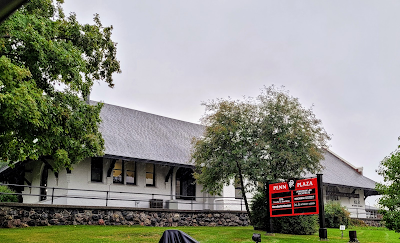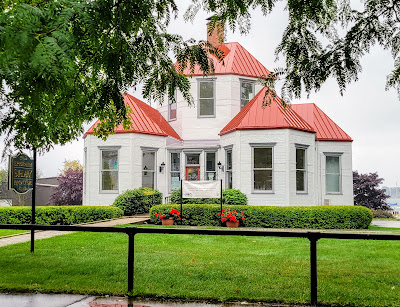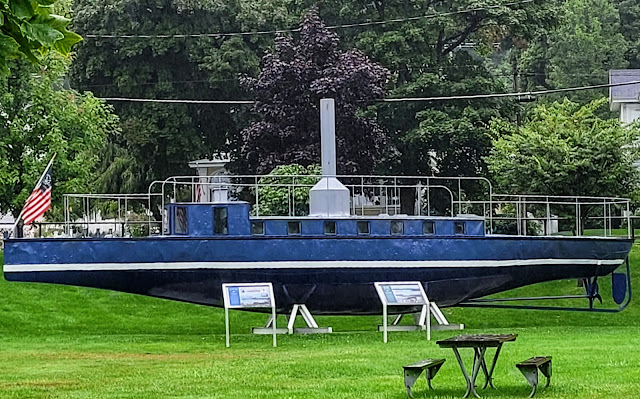…continuing with our late summer road trip to Michigan and beyond.
Since it was still a bit rainy, we decided to drive around Petoskey and the nearby town of Harbor Springs to see what interesting buildings or places that we could find.
Penn Plaza, which is located at 9
Pennsylvania Plaza, is the site of the first railway depot in Petoskey. The original depot burned down in 1899 and
was rebuilt in brick. The Grand Rapids
and Indiana Railroad operated here until 1920, when that railroad was purchased
by the Pennsylvania Central Railroad.
Unfortunately, the other side of the building has had an addition that
does nothing positive for this historic landmark. Current occupants of the old depot include 2
architectural firms, another company specializing in interior design, a CPA’s
office and an environmental tech firm.
As we drove north from Petoskey, we
‘discovered’ an amazing assortment of Victorian era homes in the town of Bay
View. “The Lilacs”, as this one is
named, really caught our eye. I was
unable to find anything directly related to its history except that it is
referred to as a “Folk Victorian Cottage”.
In actuality, Bay View is almost all
part of the Bay View Association of the United Methodist Church. It’s an example of two “only in America”
community formats: the Methodist camp meeting and the independent Chautauqua. The Association was founded in 1876 as the
country’s only ‘romantically-planned campground. It was adapted for the Chautauqua format from
1885 to 1915. This ‘ideal’ Victorian
summer community has remained in continuous operation ever since it was founded.
The Bay View Association’s grounds
cover about 340 wooded acres and it includes roughly 440 ‘cottages’ as well as
30 community-owned structures. The
Association even has its own post office despite the fact that the ‘camp’ is
closed and all the cottages are vacated from November through April. Owners of the cottages lease the land under
their seasonal homes from the Association.
In turn, the owners are charged annual Chautauqua fees and taxes.
The center of the Bay View Association
Community is referred to as The Campus…originally Tabernacle Park. Many of the larger communal structures are
located here, including the original 1877 preaching stand and an 1880 book
store. Also, in season, both
accommodations and dining opportunities are open to the public. The ‘Terrace Inn’ and ‘1911 Restaurant’ were
first opened in the summer of 1911.
To learn more about the Bay View
Association and the opportunities it offers, go to https://www.bayviewassociation.org/.
Here is yet another spectacular example of one of the larger Bay View Association cottages. Nearly all of the structures in Bay View were built between 1875 and 1900. Most were built in the Eastlake or Stick style but there are some cottages that were constructed in the Queen Anne and Shingle style architecture. Cottages are set on 50-foot lots along gently curving streets that follow the natural terraces of the land.
Interestingly, under an 1889 Michigan
state law, the Bay View Association can appoint a board of assessors, deputize
its own marshal and maintain streets and buildings on collectively owned
land. Bay View Association has always
been open to all people as regards events, visits, etc. The association requires cottage owners to
have ‘good moral character’ and that owners be practicing Christians, ideally
members of the United Methodist Church.
In 1959 the association did away with the requirement that owners be
Caucasian, but other restrictions, including one that set a quota on the
percentage of Catholic cottage owners, remained in place.
Needless to say, legal actions have
been initiated to change the rules. A
lawsuit on behalf of Bay View Chautauqua Inclusiveness Group against the Bay
View Association of the United Methodist Church was filed in 2017. It alleged religious discrimination under the
First Amendment as well as violations of the Federal Fair Housing Act, as well
as Michigan’s Constitution and related civil rights laws. Much of the problem stems from owners not
being able to leave their cottages to a surviving spouse or children because of
their religion. Specifically, one
individual who would have inherited her parents’ fourth generation cottage, was
denied membership and the right to be a co-owner because she had converted to
Judaism. Cottagers cannot sell on the
open market and they are left with only a ‘small segment of willing
buyers”. While there apparently have
been further modifications to the restrictions imposed by the Bay View
Association, it appears that legal actions have continued with some agreements
reached and a judge is supervising the required progress.
This is a ‘fly-by’ photo of the Grand Rapids and Indiana Railroad Harbor Springs Depot. It is included on the National Register of Historic Places. When the railroad built a line to Petoskey in 1874, a major influx of new residents followed. The Village of Harbor Springs was incorporated in 1880, a branch line was built to service Harbor Springs in 1882 and the depot was built to serve the railway in 1889. The depot was at the end of an 8 mile short line which was used for summer season trains that were timed to meet up in Petoskey with the Pennsylvania Railroad’s “Northern Arrow”.
The Northern Arrow was one of the named
Pennsylvania Railroad passenger trains serving St. Louis Missouri, Cincinnati
Ohio, Chicago Illinois and Mackinaw City Michigan. It was popular with northbound travelers
headed for popular Northern Michigan tourist destinations such as Charlevoix,
Petoskey, Mackinaw City and Mackinac Island.
The last passenger train stopped here in 1961. The old depot has served several purposes
since then.
Interestingly enough, the Bay View
Association chose its ‘camp site’ based on the availability of rail
service. The group considered a number
of locations but in the end they made a deal with the citizens of Petoskey and
the Grand Rapids and Indiana Railroad.
The citizens of Petoskey paid to extend the railroad to Bay View, the
railroad would purchase the site/property, and the Association would improve
the property and hold camp meetings there for at least 15 years.
The Shay Hexagon House is located at 396 East Main Street in Harbor Springs Michigan. It used to be part of a 3-structure complex which included a machine shop and waterworks that had been built by Ephraim Shay. Sadly, the machine shop and waterworks have been demolishes.
Shay was born in Ohio in 1939, moving
to Michigan in 1864 and to Harbor Springs in 1888. He was well known as the inventor of the Shay
Locomotive, which were typically used in the logging industry. Upon his arrival in Harbor Springs, he built
his octagonal house as his residence as well as a nearby machine shop where he
actually constructed some of his locomotives as well as various tools. Subsequently Shay built a waterworks, which
supplied Harbor Springs and Harbor Point with up to 100,000 gallons of water a
day. A reservoir was constructed in
1894. Shay lived in his house until he
died in 1916. After housing a number of
commercial shops, it was purchased by a private owner and it has been carefully
restored.
Ephraim Shay invented and patented a geared steam locomotive that was primarily used in North America. As they could operate successfully on steep or poor quality trackage, Shay locomotives were especially suited for logging, mining and industrial operations. Roughly 2,770 Shay locomotives were built and today 115 of them survive in various conditions and settings. Built in 1905, the Shay locomotive shown above operates on the same tracks that it did originally. It is on the Cass Scenic Railway in West Virginia. For more information, go to https://wvstateparks.com/park/cass-scenic-railroad-state-park/.
The ‘Aha’ is an all-steel yacht that was built in 1904 by inventor Ephraim Shay. He built it as his personal yacht, staring construction in 1891 and, after a number of design changes he finally launched it. It was built in Shay’s machine shop. In the 1890s the all-steel ‘Aha’ was a rarity as most boats were built with wood.
The Harbor Springs Area Historical
Society worked in partnership with the Industrial Arts Institute in Onaway
Michigan. Work started in 2019 to repair
the dilapidated vessel and this finished project or exhibit is on display in
Harbor Springs’ Shay Park.
This modest building is known as the Chief Andrew J. Blackbird House or as the Andrew J. Blackbird Museum. It is located at 368 East Main Street in Harbor Springs Michigan. Chief Andrew Blackbird, also known as ‘Makade-binesi’ or ‘Black Hawk’, was an Odawa (Ottawa) tribe leader, an historian and a proponent of Native American civil rights. Blackbird was born ca. 1815 and he served in a number of government posts, including US Interpreter for the Mackinac Agency and as the appointed postmaster of Little Traverse (Harbor Springs) in 1869.
Chief Blackbird purchased this house
for his family ca. 1858. When he became
postmaster, the home doubled at the post office. As postal volume grew, new residents
complained and tried to have Blackbird removed.
As a counter to the complaints, he built an addition to the house to
serve as the post office. He continued
to serve as postmaster until 1877. In
1887, Blackbird published a book entitled “History of the Ottawa and Chippewa
Indians of Michigan.
Blackbird continued to live in the
house until 1908 and his wife and sons lived here for many years, the last of
them dying in 1947. Then it was sold to
the Michigan Indian Foundation and it was opened as a museum. The City of Harbor Springs purchased it in
1964 with the stipulation that if continued to operate as a museum of American
Indian artifacts. To learn more, go to https://petoskeyarea.com/places/andrew-blackbird-museum/.
That’s about all for now… Just click on
any of the photos to enlarge them.
Thanks for stopping by for a visit!
Take Care, Big Daddy Dave









Those houses are really gorgeous, esp. the Lilacs, even the modest building looks pretty cool! Have a wonderful holiday season, David!
ReplyDeleteVery interesting about Bay View but those huge places to seem to fit my idea of cottages.
ReplyDeleteWhat a great history of Bay View...and just looking at those cottages takes me back to the Victorian times! I see ladies with parasols, and gentlemen with their favorite horses. I do hope they open up their regulations, imagine, just a certain number of Catholics allowed! Loved seeing the Shay house, and one of his engines. But what a funny little boat...tiny propeller (no intention of going fast there). With that chimney, I would guess some kind of steam power. THis was most enjoyable as I hunker down for 3 days inside from the cold.
ReplyDelete